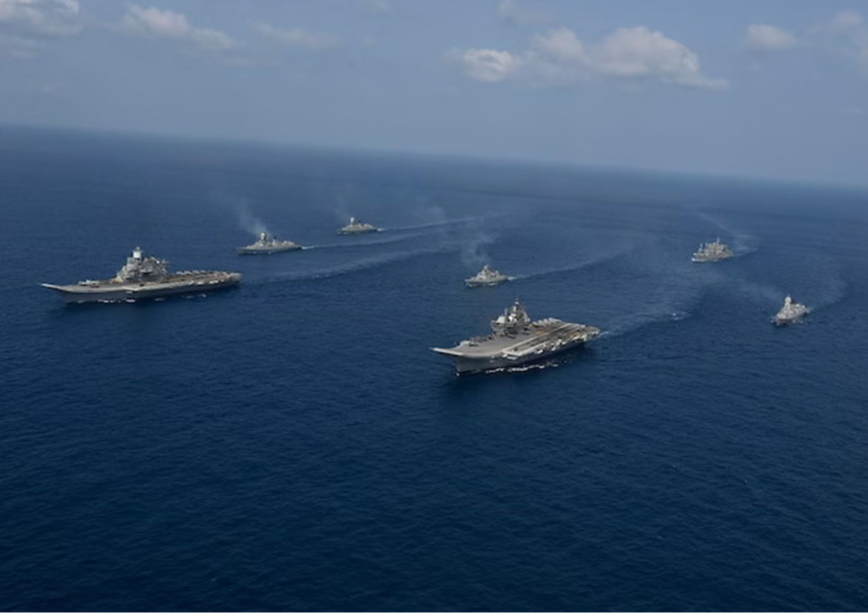The Indian Navy (IN) has embarked on its largest deployment in the Gulf of Aden and Western Arabian Sea. This deployment is not part of the ongoing US-UK military action against the Iran-backed Houthi rebels in Yemen. The IN’s unprecedently large naval flotilla consists of 12 warships, with two advanced vessels deployed in the Gulf of Aden and the remaining 10 in the Northern and Western Arabian Sea. This deployment marks a significant shift from previous deployments in these areas, both in terms of strength and the scale of the mission underway. Anti-piracy and anti-hijacking operations have been the central feature of the IN’s ongoing mission, which also has a significant naval special operations force complement.
A spate of piracy-related attacks has sprung a surprise in the Gulf of Aden and the Northern and Western Arabian Sea after a lull of almost six years. Somalia-based pirate groups went on a rampage during the period between 2008 and 2018. However, since 2018, there were either none or a negligible number of piracy incidents until late 2023. Exploiting the chaos generated by the war between Israel and Hamas, and the Iran-backed Houthi militia targeting merchant shipping belonging to Israel and its Western supporters in the Gulf of Aden and the Red Sea, pirates have made a comeback and launched attacks.
Anti-piracy and anti-hijacking operations have been the central feature of the IN’s ongoing mission, which also has a significant naval special operations force complement.
It is against this backdrop that the IN has been ordered to deploy with considerable strength and significantly greater purpose than at any time since 2008 when it first patrolled and was deployed to defeat hostile action by pirates in the Gulf of Aden . Indeed, India’s current naval presence exceeds that of any other country in the areas of the East African coast and the Gulf of Aden. Unlike in the past when the IN was greatly hamstrung by defensiveness, excessive caution, and an inward orientation, the change in the IN’s deployment patterns are largely a product of the growing confidence within the IN’s leadership and capabilities.
Furthermore, in the late 2000s, the IN’s presence in the waters of the North-Western Arabian Sea and the Gulf of Aden was limited. Its naval action to tackle anti-piracy missions was constrained to the extent that a single combat vessel, when deployed from India’s surface fleet, achieved some successes but was inadequate both in terms of capability deployed in the theatre of operations and collaborative engagements with countries on the East African coast, Gulf Cooperation Council (GCC), and other navies.
The region in which the IN’s surface vessels are currently deployed to combat piracy has a surface area of 2.5 million square nautical miles, making it very daunting to patrol for any single navy. However, the current deployment indicates there is greater capacity within the IN and an understanding of how to execute complex anti-piracy operations effectively, expeditiously and even bloodlessly over a wide expanse of water.
The region in which the IN’s surface vessels are currently deployed to combat piracy has a surface area of 2.5 million square nautical miles, making it very daunting to patrol for any single navy.
From a geopolitical standpoint, this commitment has been explained by External Affairs Minister S Jaishankar thus: “We will not be considered a responsible country when bad things are happening in the surrounding country and we say ‘I have nothing to do with this’.” This reflects New Delhi’s stronger commitment to assuming operational burdens in order to ensure the safety of commercial shipping and freedom of navigation through strategically vital waterways.
The latest resurgence in pirate attacks has disrupted the movement of shipping and led to several incidents of hostage-taking. The IN has responded very robustly and effectively to a series of attacks by pirates, marking a shift from the past in terms of the number of rescues it has conducted. In early January, the IN’s Marine Commandoes (MARCOS), deployed on the guided-missile destroyer INS Chennai, rescued a Liberia-flagged vessel with 15 Indian crew members enroute to Bahrain. On January 26, the INS Vishakhapatnam responded to a distress call from a United Kingdom (UK)-linked tanker, which was struck by a Houthi missile . Subsequently, the INS Sumitra, a patrol vessel, rescued two hijacked vessels off the coast of Somalia in late January. In the first rescue on January 28, the Indian warship rescued the crew from pirates who had captured an Iranian-flagged vessel. Forty-eight hours later, the INS Sumitra again rescued another Iranian flagged vessel, with 19 Pakistani crew aboard. All these operations carried out by the IN demonstrate rapid response capabilities and sustained operational performance of the service. Nevertheless, the latest string of pirate attacks appears to be nowhere nearly as high in frequency and intensity as they were during the decade between 2008 and 2018. Yet the sudden burst of piracy of late has not occurred in a vacuum but due to the fact that West Asia remains a veritable geopolitical powder keg that mandates a high Indian naval alert posture.
This commentary originally appeared in Business Standard.
The views expressed above belong to the author(s). ORF research and analyses now available on Telegram! Click here to access our curated content — blogs, longforms and interviews.




 PREV
PREV



